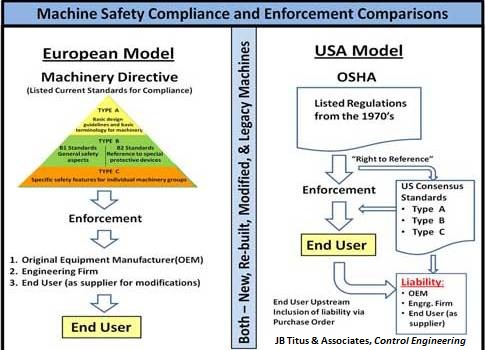A lot of work has gone into harmonizing international machine standards but a dilemma still exists – who is responsible? Ensure you know the answer.

A lot of work has gone into harmonizing international standards but a dilemma still exists – who is responsible? International standards have been the subject of many articles and blogs over time. I have authored several for Control Engineering, and I’ve participated in both domestic and international standards committees for more than 10 years.
It’s my experience that international standards are heavily influenced by the concentrated countries of Europe because typically each country has one vote. Europe is also heavily influenced by law, which for them is called the Machinery Directive. The U.S. machine safety standard outlook is a bit complex. However, OSHA is first in line for U.S. enforcement. OSHA is then backed up by a court system for litigation. Then, overshadowing our entire system are influences like due diligence, best-in-class, workers compensation, insurance, and other considerations.
Here’s the deal as I see it. It doesn’t really matter if machine safety “enforcement” is first in line or in the background. However, enforcement does matter when it comes to applying the standard to a given machine within a country. Case in point: The international standards in which I have been involved explain in their scope section that they are written for the “designers” as first in line. Why? In my opinion the Machinery Directive considers original equipment manufacturers (OEMs) and engineering firms as the suppliers of machinery, and those companies have the designers. Therefore, the machine “designers” have compliance responsibility.
But, in the U.S., OSHA clearly states that its regulations targets manufacturers, which we say are the end users (of machinery). OSHA states that every employer must have a safe work place. Great! So, when OSHA visits an OEM representatives inspect the manufacturing but they don’t inspect the machine that they’re manufacturing. In the U.S., that machine is only possibly inspected once it’s installed at an end user’s facility. Therefore, first in line for enforcement in the U.S. is the end user, many of which do not have machine “designers.”
Who is responsible in the U.S. when a company chooses to follow and adopt an international standard (IEC, ISO, etc.) when that standard states that “designers” shall comply? For enforcement purposes, what if a particular end user doesn’t have “designer” responsibility or capability? Consultants in these situations sometimes advise end user companies to include these responsibilities in purchasing contracts to transfer the responsibility up stream. There are other solutions also, but most of them involve contracts and legal resources to help mold the application and enforcement of an international standard to the U.S. model of enforcement. In contrast (and to harmonize with international standards), over the past 10 years many of our domestic standards have been updating the “responsibility” for compliance to include upstream resources, like OEMs.
I believe it’s still a work in progress!
Has this presented you with any new perspectives? Do you have some specific topic or interest that we could cover in future blog posts? Add your comments or thoughts to the discussion by submitting your ideas, experiences, and challenges in the comments section below.
Related articles:
Machine Safety: ISO 13849-1 is mandatory for conformity to the Machinery Directive in Europe but in the USA?
Machine Safety: Domestic U.S. versus international standards
Inside Machines: Does adopting ISO 13849-1:2006 change the U.S. model for compliance and enforcement?
Contact: https://www.jbtitus.com for “Solutions for Machine Safety”.



